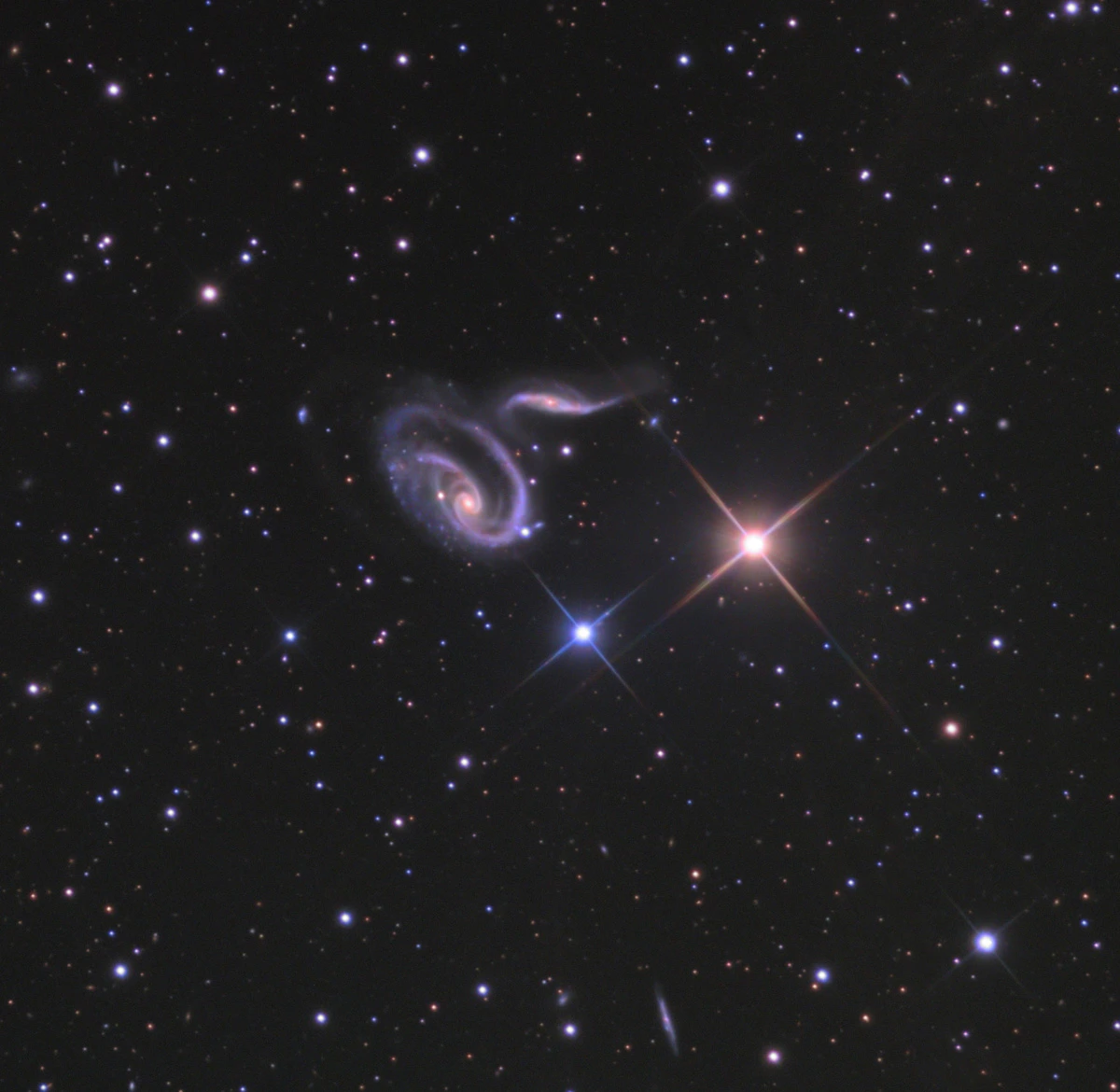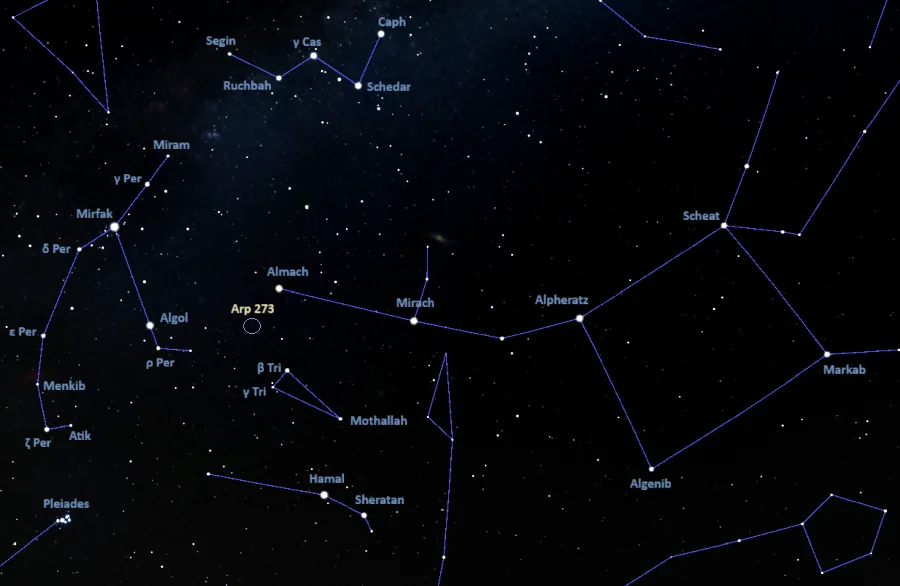The Rose Galaxy is a pair of interacting spiral galaxies located approximately 300 light years away in the constellation Andromeda. The interacting duo – UGC 1810 and UGC 1813 – is catalogued as Arp 273 in the Atlas of Peculiar Galaxies. It was famously imaged by the Hubble Space Telescope (HST) in 2010.
The structures of both galaxies have been heavily distorted and intertwined by gravity. Tails of stars and gas have been pulled out of the galaxies’ spiral arms because of the close encounter. The disk of the larger UGC 1810 has been stretched out into a flower-like oval, while the smaller companion UGC 1813 appears to tug at its larger neighbour, giving the cosmic flower a stem. Both galaxies are classified as peculiar because of the tidal distortion.
UGC 1810 has an apparent visual magnitude of 12.92 and an angular size of 1.2 by 0.504 arcminutes. Its smaller neighbour UGC 1318 shines at magnitude 14.21 and has an apparent size of 0.833 by 0.217 arcminutes. The interacting pair is moving away from us at over 7,000 km/s. The galaxies are separated by only tens of thousands of light years and connected by a tidal bridge of material.

This Hubble Space Telescope image shows a group of interacting galaxies called Arp 273. The larger of the spiral galaxies, known as UGC 1810, has a disk that is tidally distorted into a rose-like shape by the gravitational tidal pull of the companion galaxy below it, known as UGC 1813. A swath of blue jewels across the top is the combined light from clusters of intensely bright and hot young blue stars. These massive stars glow fiercely in ultraviolet light. The smaller, nearly edge-on companion shows distinct signs of intense star formation at its nucleus, perhaps triggered by the encounter with the companion galaxy. A series of uncommon spiral patterns in the large galaxy is a tell-tale sign of interaction. The large, outer arm appears partially as a ring, a feature seen when interacting galaxies actually pass through one another. This suggests that the smaller companion actually dived deep, but off-center, through UGC 1810. The inner set of spiral arms is highly warped out of the plane with one of the arms going behind the bulge and coming back out the other side. How these two spiral patterns connect is still not precisely known. A possible mini-spiral may be visible in the spiral arms of UGC 1810 to the upper right. It is noticeable how the outermost spiral arm changes character as it passes this third galaxy, from smooth with lots of old stars (reddish in color) on one side to clumpy and extremely blue on the other. The fairly regular spacing of the blue star-forming knots fits with what is seen in the spiral arms of other galaxies and is predictable based on instabilities in the gas contained within the arm. The larger galaxy in the UGC 1810 – UGC 1813 pair has a mass that is about five times that of the smaller galaxy. In unequal pairs such as this, the relatively rapid passage of a companion galaxy produces the lopsided or asymmetric structure in the main spiral. Also in such encounters, the starburst activity typically begins in the minor galaxies earlier than in the major galaxies. These effects could be due to the fact that the smaller galaxies have consumed less of the gas present in their nucleus, from which new stars are born. Arp 273 lies in the constellation Andromeda and is roughly 300 million light-years away from Earth. The image shows a tenuous tidal bridge of material between the two galaxies that are separated by tens of thousands of light-years from each other. The interaction was imaged on December 17, 2010, with Hubble’s Wide Field Camera 3 (WFC3). Image credit: NASA, ESA, and the Hubble Heritage Team (STScI/AURA) (CC BY 2.0)
The larger UGC 1810 is comparable in size to the Milky Way. The galaxy has a tidally distorted spiral structure with warped inner spiral arms and a large outer arm that appears partly as a ring. This has been known to happen when a smaller galaxy passes through its larger neighbour. The northern part of UGC 1810 hosts many young clusters of hot blue stars that appear as blue patches in the galaxy’s outer spiral arm.
A 2014 study adopted a distance of 109.8 megaparsecs (358 million light-years) for UGC 1810 and found a radius (R25) of 28 kiloparsecs (91,324 light -years) and a star formation rate of 2.37 solar masses per year.
The smaller companion galaxy UGC 1813 appears almost edge-on. It has about a fifth of its larger neighbour’s mass. The central portion of the galaxy shows signs of active star formation. The intense star forming activity in both galaxies was likely triggered by the interaction.

Rose Galaxy (Arp 273), image credit: Adam Block/Mount Lemmon SkyCenter/University of Arizona (CC BY-SA 3.0 US)
Facts
Arp 273 was probably discovered by the astrophysicist Boris Aleksandrovich Vorontsov-Velyaminov on photographic plates obtained during the Palomar Observatory Sky Survey in the 1950s. Vorontsov-Velyaminov listed the pair as VV 323 in his Atlas and Catalogue of Interacting Galaxies, published in 1959.
UGC 1810 and UGC 1813 are listed as Arp 273 in American astronomer Halton Arp’s Atlas of Peculiar Galaxies (1966). In his note, Arp wrote, “Position of large spiral. Bright long well defined arms, but smooth, not patchy.”
UGC 1810 hosted a supernova, SN 1962R, in 1962. SN 1962R was classified as a type II supernova and had an apparent magnitude of 15.9 at the time of discovery. It occurred in the galaxy’s spiral arm, 28 arcseconds northeast of the galactic nucleus. The supernova was discovered on photographic plates taken at the Lick Observatory in December 1962.

This interesting pair of interacting spiral galaxies was first described in the Catalogue of Peculiar Galaxies, compiled by Halton Arp in 1966. It is also pair number 64 in Igor Karachentsev’s catalog of binary galaxies. The larger member is strongly tidally distorted, looking almost as though one side of the galaxy has been placed under a magnifying glass. The edge-on companion, however, retains a relatively undisturbed spiral disk, but has a luminous, heavily obscured but infrared-bright, star-burst nucleus. The nucleus of the large spiral, by way of a contrast, contains a low-ionization nuclear emission-line region (LINER), which is indicative of much less activity than the bright nuclear HII region of its companion. We thus see an interesting example of the very different responses that different galaxies can have to interaction with their companions: the large galaxy has a shredded disk but essentially nothing in its nucleus, while the small galaxy has an undisturbed disk but a very active nucleus. Credit: WIYN/NOIRLab/NSF (CC BY 4.0)
Location
The Rose Galaxy lies in the eastern portion of Andromeda, in the same region as the bright open cluster NGC 752 and the Silver Sliver Galaxy (NGC 891). It appears southeast of Almach, the easternmost star in the chain of three bright stars that begins with Alpheratz in the Great Square of Pegasus. The interacting pair lies about two fifths of the way from Algol in Perseus to Mirach in Andromeda.
Arp 273 is a challenging target for amateur telescopes because the two galaxies appear faint and small. The details of the cosmic encounter are best seen in long-exposure photographs.

Location of the Rose Galaxy (Arp 273), image: Stellarium
Rose Galaxy – Arp 273
| Constellation | Andromeda |
| Object type | Interacting galaxies |
| Morphological type | SA(s)b pec[3] + SB(s)a pec |
| Apparent magnitude | 12.92 + 14.21 |
| Distance | 300 million light-years |
| Names and designations | Arp 273, APG 273, VV 323, ZW V 223, KPG 64 |
UGC 1810
| Object type | Spiral galaxy |
| Morphological type | SA(s)b pec |
| Right ascension | 02h 21m 28.7063465592s |
| Declination | +39° 22′ 32.121363216″ |
| Apparent magnitude | 12.92 |
| Apparent size | 1.200′ × 0.504′ |
| Redshift | 0.02508 ± 0.00023 |
| Heliocentric radial velocity | 7426 ± 68 km/s |
| Names and designations (UGC 1810) | UGC 1810, LEDA 8961, PGC 8961, MCG+06-06-023, CGPG 0218.4+3909, Z 523-28, Z 0218.4+3909, UZC J022128.6+392231, [HVG99b] 02184+3909, KPG 64a, VV 323a, Gaia DR2 332053546677806592, Gaia DR3 332053546678251904 |
UGC 1813
| Object type | Barred spiral galaxy |
| Morphological type | SB(s)a pec |
| Right ascension | 02h 21m 32.5507381500 s |
| Declination | +39° 21′ 24.245304354″ |
| Apparent magnitude | 14.21 |
| Apparent size | 0.833′ × 0.217′ |
| Redshift | 0.024467 ± 0.000153 |
| Heliocentric radial velocity | 7245 ± 46 km/s |
| Names and designations | UGC 1813, LEDA 8970, PGC 8970, MCG+06-06-024, 2MFGC 1826, IRAS 02184+3907, 2MASX J02213261+3921246, Z 523-29, Z 0218.5+3908, PSCz Q02184+3907, UZC J022132.7+392124, [HVG99b] 02185+3908, [MWI88] ACO 347 7, KPG 64b, VV 323b, Gaia DR2 332053271799904640 |